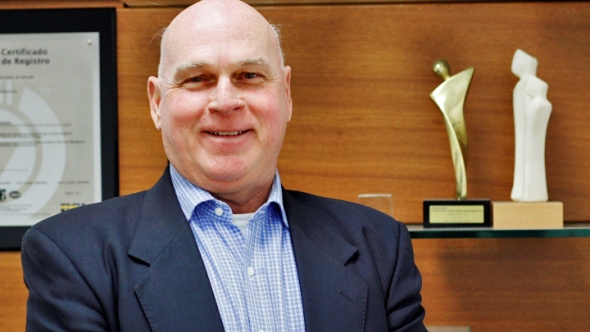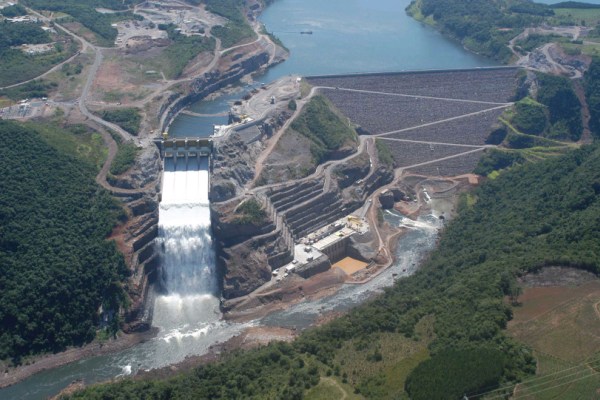Hydroelectric Power on the Rise in Santa Catarina
Carlos Alberto Bezerra de Miranda, Chief Executive Officer of ENERCAN, BAESA and Consórcio Machadinho
Carlos Alberto Bezerra de Miranda talks about hydroelectic power, which is rising in Santa Catarina. He mentions some of the benefits brought by this type of construction and also the challenges he has to face.
Interview with Carlos Alberto Bezerra de Miranda, Chief Executive Officer of ENERCAN, BAESA and Consórcio Machadinho

Your future project should have two phases: construction and development. How do you relate that with environment, with social environment? What is your model for the future project?
The State of Santa Catarina is a good partner for investors. Bring your resources and invest here. This is a proactive State with a quality labor and it’s filled with opportunities. It’s also a very beautiful State. It’s definitely a very good place for investment.
We have a saying: “we can’t make an omelet without breaking the eggs” – we break the eggs in the construction phase and we enjoy the beautiful project – the hydroelectric power plant – in the operation phase. The hydroelectric power plant forms a beautiful lake of 110 km in length and 1km in width located in a very poor place. There used to be 79 families living inside the area of the hydroelectric power plant but the development extended benefits to almost 600 families. Every person affected by the development had their income and well-being improved. There is a commitment to improve the well-being of the people that were compulsorily relocated. The people, who were dependant in some way on the land which became later occupied by the company (including those who didn’t live there), received fantastic compensations and training in order to have improved living standards.
Can you give us an example of the compensations and training?
The location of the power plant is in a sloping terrain. The people would plant their seeds and they would return to harvest them with the help of animals, because the terrain could not be reached by a vehicle. Each relocated family is now an owner of an area with around 23 acres of land, a house, running water, electricity, a barn and the families also received an amount as a help and support until their first harvest. All of this was made for the people affected by the development. All communities surrounding the development are poor communities (of course, we can’t choose to build a development like this in the middle of São Paulo) that lack everything. We have a social commitment, a social responsibility to integrate such a development in this region. We have a large number of social, cultural and income oriented projects which allow for a great development of the region. We are in a contact with public authorities – municipalities, departments of education, governors, state departments, and, in some cases, with federal governments.
The message we should transmit here in the south, especially in Santa Catarina, is that we a have a proactive government that is a partner in the regional development – they are our friends and not our enemies. I usually say that our mandate here in the region has a 65 years duration and, if we are going to have neighbors during 65 years, we want to get along with them. We are here to stay for quite a long period of time. We have numerous resources to invest in this region, including fiscal exemption benefits, the Childhood and Adolescence Fund – the Brazilian legislation promotes the use of these resources for the community development. Here in Santa Catarina we can spend all the encouraged resources and also some resources that are not encouraged (that come from shareholders) for sustainable development.
In Santa Catarina we found space to make things work: we have here a very good example of a construction of a beautiful integrated hydroelectric power plant, which is promoting economic growth, improving the life of the population and improving the environmental sustainability. We have won several prizes in the environmental and social areas.
Can you give us factual examples of what was done in terms of culture and society?
As far as social and cultural projects are concerned, we invested as much as 1.2 million dollars in the Barra Grande power plant. In the Campos Novos power plant we invested a little bit less. Together with what was invested in the Machadinho power plant we invested around 3 million dollars.
We have a partnership with the Orquestra Camerata (Camerata Orchestra) from Florianópolis which has a series of cultural activities. Alongside with them, we created a course for people from the inland where the power plant is located – projects of music apprenticeship for the people around the areas of the power plants.
We take theatre plays and cinema presentations to these places as there are no movies or theatres.
The Instituto Guga Kuerten (Guga Kuerten Institute) has a project called “Campeões da Vida” (Life’s Champions) that promotes sport into some regions in order to prevent kids from criminal activities or drugs. We were their partners in the Campos Novos municipality and the results were a better physical capacity of the students and an educational improvement.
All these projects involve professionals and almost all of them are recruited in the region. All these activities mentioned are a synonym of development for the region.

How many people does the development include?
It’s difficult to precise a number. We try to identify how many people each project reaches. We have been operating for almost 10 years and we have reached almost 1.2 million people who benefited from those projects.
This is an example for other types of projects that can be implemented in Brazil, isn’t it?
There’s no doubt about it. I can’t build a hydroelectric power plant without an entrepreneurial commitment with these types of activities after construction. The hydroelectric power plant occupies a physical space and it pays a tax for using a public property. Besides the payment of this tax, there is also the issue of coexistence. The development generates income and part of this income stays in the region for its development.
We have a program to attract talents and to train maintenance personnel from the region. We take 17 or 18 years old young people and we train them to be future operators and future maintenance workers in our plants – that brings us an advantage of lowering the personnel turnover and it raises the satisfaction level as the people don’t have to look for a job outside of our region. We currently have a big educational project in the area of power plants.
As a manager of three companies, what’s the biggest challenge you face?
The biggest challenge is to maintain the excellence tradition we built. With Santa Catarina’s help we were able to build a wonderful thing that is repeatable in other places (as environmental agencies said).
We have now approved the Plano de Conservação e Uso do Entorno do Reservatório (Reservoir Conservation and Use Plan) with the IBAMA – Instituto Brasileiro do Meio Ambiente e dos Recursos Naturais Renováveis (Brazilian Institute for the Environment and Renewable Natural Resources). There are 35 other developments awaiting an approval and Barra Grande was the first to be approved to serve as a reference for the others.
Is there any criticism from the environmental activists you have to face?
Criticism is very frequent. The construction of a dam in a river causes a series of obstacles to the environment. Fish can’t pass through a 200 m high dam, so the circulation of fish is compromised. This is impacting the environment and thus many people are against the construction of dams. Barra Grande was even elected as an icon of an environmental struggle. It’s important that we also show the good things a power plant can bring along. The main message I would like to transmit is that people should look at a power plant in a positive way. It caters for clean and renewable energy and the region where this plant is located greatly benefits (structural projects).
Considering the pros and cons, the hydroelectric power plant is an asset to Brazil. Large equipment is supplied by big international suppliers but it’s all being manufactured in Brazil. The engineering is Brazilian, the construction is Brazilian.
I’m a passionate defender of the hydro generation of power, because it’s an advantage for a country like Brazil that needs to develop, grow and expand. Hydroelectrics expand that wealth into the inland and pay a high monthly tax to the region.
It’s also a technology that can be exported to other countries.
Of course it is. We have several examples of Brazilian companies working in Latin America or Africa and exporting the know-how acquired in Brazil.
What would be your message to a national or an international investor?
The final message would be an optimistic one. The State of Santa Catarina is a good partner for investors. Bring your resources and invest here. This is a proactive State with a quality labor and it’s filled with opportunities. It’s also a very beautiful State. It’s definitely a very good place for investment.